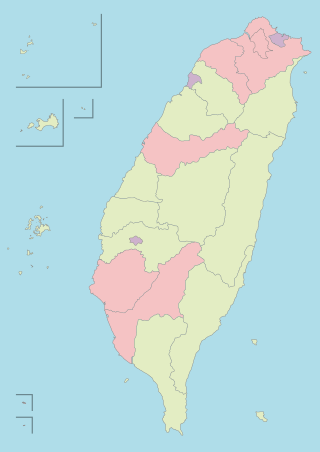Other places
- Shrine of the Canadian Martyrs in Midland, Ontario
- Munyonyo Martyrs' Shrine, in Munyonyo, Kampala, Uganda
- National Shrine of the North American Martyrs in Auriesville, New York, United States
A martyrs' shrine or martyr's shrine is any shrine in honour of a martyr or martyrs. It may refer to:
Highways in Taiwan are classified into five types:
An art centre or arts center is distinct from an art gallery or art museum. An arts centre is a functional community centre with a specific remit to encourage arts practice and to provide facilities such as theatre space, gallery space, venues for musical performance, workshop areas, educational facilities, technical equipment, etc.

Taichung is located in central Taiwan and is the second largest city in the island country.

The Ministry of Transportation and Communications governs transportation in Taiwan.
Articles related to Taiwan include:
The regions of Taiwan are based on historical administrative divisions. However, most of the definitions are not precise.
The Taiwan High Prosecutors Office is located in Taipei, Taiwan. The territorial jurisdiction covers the jurisdictions of Taipei, Shilin, New Taipei, Taoyuan, Hsinchu, Keelung and Yilan District Prosecutors Offices. It has branch offices in Taipei, Tainan, Kaohsiung, Hualien and Taichung. It is one of the two high prosecutors offices in Taiwan.
National Water Life Saving Association (NWLSA), also known as Chinese Taipei Water Life Saving Association (CTWLSA), is the major lifesaving organization in Taiwan. The organization's members are mainly volunteer lifesavers, police officers, firefighters and civilians who are enthusiastic about water sports, water safety awareness and water rescue events.
Districts are administrative subdivisions of the Republic of China (Taiwan)'s special municipalities of the second level and provincial cities of the third level formerly under its provinces. There are two types of district in the administrative scheme.

Voice of Han Broadcasting Station also known as Voice of Han Chinese Broadcasting Station was founded in 1942 by the Ministry of National Defense. It is headquartered on Xinyi Road in the Zhongzheng District of Taipei, Taiwan.
Taiwan This Month is a free monthly tourist magazine aimed at providing essential information to business travelers, tourists and immigrants to Taiwan, with a focus on people between 28 and 55 years of age.
The Guesthouses of Chiang Kai-shek were built in order for the former President of the Republic of China, Chiang Kai-shek, to have places to stay while travelling on inspection tours and holidays around Taiwan. According to current Republic of China statistics, there are 30 guesthouses in Taiwan which were used by Chiang during his lifetime. Many have been transformed into museums, art and literature centers, and tourist hotels.

Special municipality, historically known as Yuan-controlled municipality is a first-level administrative division unit in the Republic of China (Taiwan). Under the administrative structure of Taiwan, it is the highest level of division in Taiwan and is equivalent to a province. Since the streamlining of provinces in 1998, the special municipalities along with provincial cities and counties have all governed directly under the central government.
The architecture of Taiwan can be traced back to stilt housing of the aborigines in prehistoric times; to the building of fortresses and churches in the north and south used to colonize and convert the inhabitants during the Dutch and Spanish period; the Tungning period when Taiwan was a base of anti-Qing sentiment and Minnan-style architecture was introduced; in Qing dynasty period, a mix of Chinese and Western architecture appeared and artillery battery flourished during Qing's Self-Strengthening Movement; During the Japanese rule of Taiwan, the Minnan, Japanese and Western culture were main influencers in architectural designs and saw the introduction and use of reinforced concrete. Due to excessive Westernization as a colony, after the retrocession of Taiwan to the Republic of China in 1945 from Japan at the end of World War II, Chinese classical style became popular and entered into international mainstream as a postmodern design style. Today, Taiwanese architecture has undergone much diversification, every style of architecture can be seen.

Martyrs' shrines or hero shrines are religious buildings used in Chinese hero cults. They are a kind of Ci Shrine, which is a separate building built to praise the spirit of loyalty and righteousness, and to memorialize the martyrs who died for the country. In addition to shrines dedicated to martyrs and loyal subjects, some of them are converted from other buildings, such as Shinto shrines. Since Confucianism advocates the virtues of loyalty and righteousness, the construction of the Temple not only commemorates and enshrines the martyrs who were martyred in the country, but also serves the purpose of moral education.